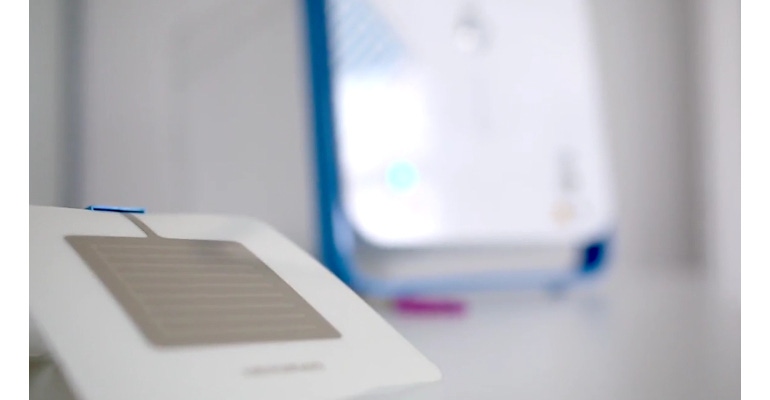Coldplasmatech and Schreiner ProTech partnered to redesign a cold plasma solution for wound healing.
August 17, 2021

Chronic, slow-healing wounds frequently leave patients in pain and at risk of infection, greatly impacting their quality of life. “Patients suffer greatly,” said Dr. Carsten Mahrenholz, a chemist and former group leader at the Leibniz Institute for Plasma Science and Technology (INP) in Greifswald, Germany. A few years ago Mahrenholz set out to see whether the use of cold plasma could speed up wound healing. Research at Germany’s National Reference Center had previously demonstrated that cold plasma could kill bacteria and even fight antibiotic-resistant pathogens common in hospitals and hospice settings. Mahrenholz cofounded Coldplasmatech, and the company developed the CPTpatch, a line of wound dressings utilizing cold plasma supplied by the CPTcube.
“The CPTpatch generates the cold plasma right above the wound. The process is called dielectric barrier discharge,” Mahrenholz told MD+DI. “The procedure is actually quite simple: Connect the sterile patch to the cube, place the Patch above the wound (with the adhesive atraumatic frame), press the start button on the cube, and wait for two minutes until the fully automated treatment is finished. That’s the entire treatment. It is precisely reproducible, and always treats the whole wound surface (size and depth independent) optimally.”
While Mahrenholz found the approach effective, the platform proved difficult to mass produce. “We needed something lighter, more reproducible, more user-friendly,” he said. “We needed to build upon the successes of the initial CPTpatch to make it more practical.”
Coldplasmatech turned to Schreiner ProTech, a film technology company well versed in printed electronics. The new design needed a flexible conductor track structure for the wound dressing, and the application had to withstand several thousand volts from the CPTcube power source without causing electric shock.
These requirements had to be considered when selecting the materials, especially the films, Mercedes Pasquazzo, product manager of RFID and printed electronics at Schreiner ProTech told MD+DI. “Perhaps the two most important film features we need are high levels of printability and flexibility, so that it would be a suitable solution to treat a wide range of patient body parts. In addition to these requirements, the film needed to be stable enough to withstand the high electrical voltages during operation.”
Schreiner ProTech utilized foil composite materials to create the patented conductor structure capable of generating the cold plasma. The new design and materials proved cost effective. “For the new version, the manufacturing process has been optimized,” explained Pasquazzo. “While the first version used a silicone over-molding of the patch, the next-generation process replaces this setup with a completely printed structure. In addition, the patch was redesigned so that the cable for the power supply can be removed from the patch via a plug. The cable can now be reused, making the product more sustainable overall.”
“Manufacturing is performed through a fully automated roll to roll production, which is far more efficient and has a high production capacity,” added Mahrenholz. “The whole product is significantly lighter, therefore producing less waste. Whereas the initial patch and cable system weighed a combined 327 g, the latest generation comes to just 23 g, and features a reusable cable system.
“This is the first time cold plasma technology is mass market compatible, available, reliable, and applicable,” he continued. “With our solution every medical professional (not only physicians) can benefit from this rather complex technology with the push of one button. The usage of our dressings is intuitively integrated into wound treatment procedures. Also, with a treatment time of only 2 minutes, the CPTpatch is fast and, due to its user-friendly application, a safe and reliable way of treating chronic or infected wounds.”
In terms of biocompatibility testing, all relevant tests were successfully done according to MDR standards, Mahrenholz said. These include DIN EN ISO 10993 for biological evaluation of medical devices.
Each patch is individually and sterilely packaged and EtO sterilized. “The final packaging is not done at Schreiner ProTech – our packaging and sterilization partner, Puracon, performs that step,” Mahrenholz said. “The final product contains one patch, one adhesive foam frame, the EtO-compatible package ,and a label. Batches of either 5 or 10 units are packed in a slim box.
“The most interesting feature about the package for Cube and Patches is that everything can be sent by parcel and is validated this way,” he continued. “So our delivery is 24 hours from order, without special transportation needs. We try to keep all processes as efficient as possible.”
Mahrenholz explains that the patches can be stored at normal room temperatures and don’t require any special conditions to effectively function. “There is no activation process; they are delivered ready to use,” he said.
The CPTpatch and Cube are currently used and sold in Europe. Coldplasmatech does plan to enter the U.S. market and is in contact with FDA for approval, Mahrenholz said.
The company anticipates that demand for such wound care will grow significantly in as the Baby Boomer generation manages age-related ailments.
About the Author(s)
You May Also Like




